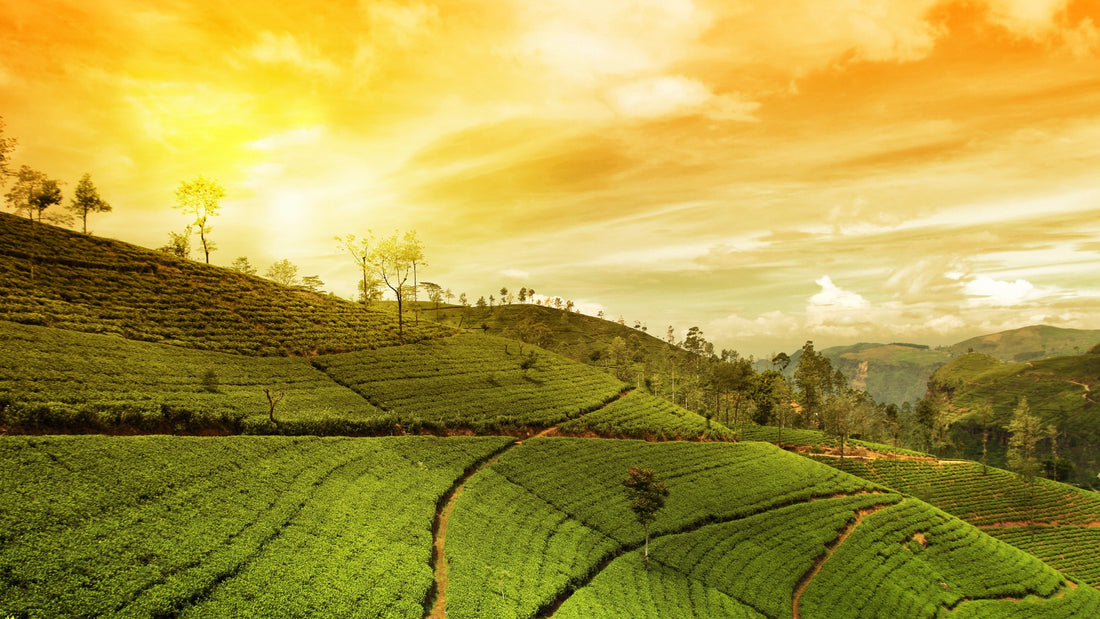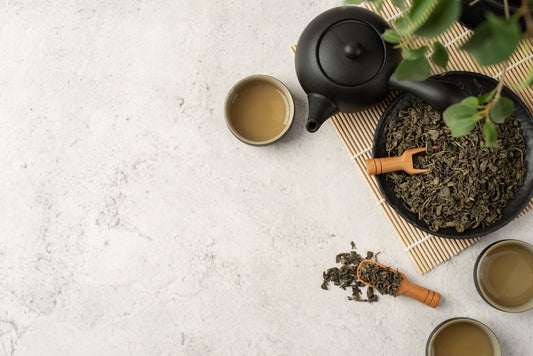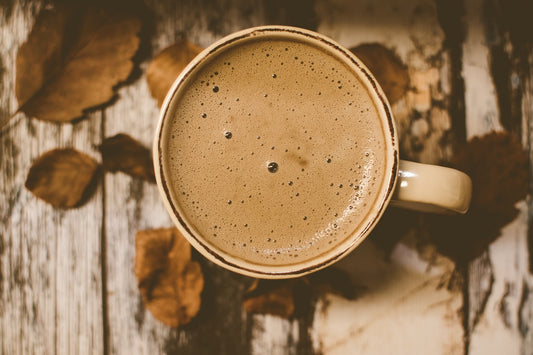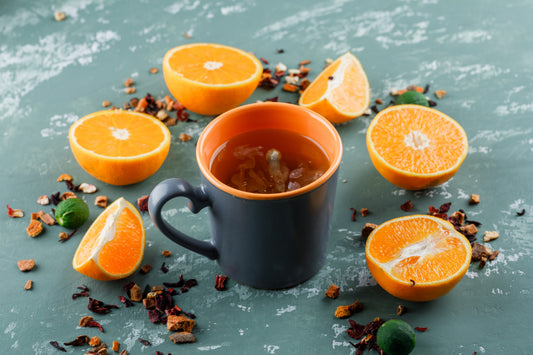Darjeeling Tea Gardens
Darjeeling tea gardens produce some of the world-famous teas that are celebrated for their distinctive flavour profile, floral aroma, and exquisite taste. Often referred to as the "Champagne of Teas," Darjeeling teas are some of the most sought-after teas around the globe.
Nestled in the foothills of the Eastern Himalayas in the Indian state of West Bengal, Darjeeling stands as an iconic name in the world of tea production. The region's lush landscapes, high altitudes, and unique climate provide an ideal environment for cultivating some of the finest tea varieties globally.
The Darjeeling tea industry has a rich history dating back to the mid-19th century when the British established the first tea gardens in the region. Since then, Darjeeling has become synonymous with high-quality, premium tea that is loved by tea connoisseurs around the world.
The region's elevation, ranging from 2,000 to 7,000 feet, contributes to the unique characteristics of Darjeeling tea, making it a prized and distinctive offering in the global tea market.
With well over 80 tea gardens spread across the beautiful landscapes of Darjeeling, each estate produces teas that are unique to its landmark. The only thing that stays common in all of Darjeeling teas is ‘the awesomeness’.
Among the 80+ tea gardens, the below 5 tea estates are not only popular for their teas, but also for their beautiful landscapes, bungalows, flora and fauna, homestays, and culture.
5 Best Tea Gardens of Darjeeling
1. Glenburn Tea Estate
A. History and establishment:
Nestled on the picturesque slopes of the Himalayas, Glenburn Tea Estate boasts a captivating history that dates back to the mid-19th century. Established in 1859 by a Scottish tea company, the estate has witnessed the evolution of Darjeeling's tea industry.
Over the years, Glenburn has transitioned through various ownerships, each contributing to its legacy. Today, it stands as a testament to the enduring tradition of tea cultivation in the region, blending the influences of British heritage with the rich cultural tapestry of Darjeeling.
B. Unique features and characteristics:
Scenic Beauty: One of Glenburn's standout features is its breathtaking natural surroundings. The estate is enveloped by lush greenery, with the sparkling waters of the Rungeet and Rung Dung rivers adding to the enchanting landscape.
The tea bushes are strategically planted on terraced slopes, creating a visually stunning panorama.
Heritage Bungalows: Glenburn Tea Estate is home to colonial-era heritage bungalows that provide guests with an immersive experience. These meticulously preserved accommodations exude old-world charm and offer panoramic views of the tea gardens.
Staying in these bungalows allows visitors to step back in time while enjoying modern comforts.
Sustainable Practices: Glenburn is committed to sustainable and environmentally friendly practices. The estate emphasizes organic cultivation methods, minimizing the use of pesticides and promoting biodiversity.
This commitment to sustainability aligns with contemporary values and contributes to the estate's appeal among eco-conscious consumers.

C. Notable tea varieties produced:
Glenburn Tea Estate is renowned for producing some of the finest Darjeeling teas, each characterized by its unique flavour profile and aromatic qualities. Notable tea varieties include:
Glenburn Estate First Flush: Celebrated for its light, floral notes and brisk character, the First Flush tea from Glenburn captures the essence of the initial spring harvest.
Glenburn Moonshine: A muscatel-flavoured tea produced during the Second Flush, known for its rich and fruity notes, with a well-defined sweetness.
Glenburn White Tea: This delicate tea is crafted from the youngest tea leaves and buds, offering a light and nuanced flavour with subtle floral undertones.
2. Makaibari Tea Estate

A. Historical background:
Makaibari Tea Estate, located in the Kurseong region of Darjeeling, has a storied history that spans more than 150 years. Established in 1859 by the pioneering landowner and philanthropist, G.C. Banerjee, Makaibari is one of the oldest tea estates in Darjeeling.
Its inception coincided with the early days of Darjeeling's emergence as a prominent tea-producing region under British colonial rule. Over the years, Makaibari has passed through several generations of the Banerjee family, each contributing to the estate's legacy and commitment to producing exceptional teas.
B. Sustainable and organic farming practices:
Makaibari is globally recognized for its steadfast commitment to sustainable and organic farming practices. The estate has embraced holistic and eco-friendly approaches to tea cultivation, minimizing the use of synthetic pesticides and fertilizers.
Makaibari was a pioneer in adopting organic farming methods, earning certification from renowned organic certification bodies. The estate's commitment extends to preserving biodiversity, implementing water conservation measures, and promoting environmentally conscious agricultural techniques.
Makaibari's dedication to sustainability aligns with contemporary environmental values and contributes to the production of teas with a unique and untainted terroir.
C. Signature teas and flavours:

Makaibari Silver Tips: This is an exquisite white tea crafted from the delicate buds of the tea plant. Makaibari Silver Tips are known for their light, floral notes and subtle sweetness, offering a unique and refreshing tea-drinking experience.
Makaibari Muscatel: During the second flush, Makaibari produces a distinctive muscatel tea that captures the essence of the region's terroir. With a rich, fruity flavour profile and a characteristic muscatel aroma, this tea is highly sought after by connoisseurs.
Makaibari Green Tea: Embracing the global popularity of green tea, Makaibari produces high-quality green teas that are fresh, aromatic, and rich in antioxidants. The estate's green teas reflect the commitment to quality and sustainability.
3. Pubong Tea Garden

A. Overview of the estate:
Nestled in the scenic hills of Darjeeling, Pubong Tea Garden is a distinguished estate that has made its mark in the world of tea production. Established in 1913,
Pubong has carved a niche for itself with its commitment to quality, traditional cultivation methods, and a focus on preserving the unique terroir of the region, characterized by rolling hills, cool temperatures, and a rich history steeped in the heritage of Darjeeling tea.
Pubong stands out not only for its picturesque setting but also for its dedication to sustainable practices and the production of teas that capture the essence of Darjeeling's terroir. The estate's tea gardens are meticulously tended to by skilled artisans who follow time-honoured techniques passed down through generations.
B. Climate and terroir influence on tea quality:
High Altitude Advantage: Situated at an elevation of 1,520 m (4,990 feet), Pubong Tea Garden benefits from the unique climatic conditions of Darjeeling. The high altitude contributes to a cooler and more temperate climate, fostering slow and steady growth of tea bushes.
This gradual growth imparts distinctive characteristics to the tea leaves, resulting in flavours and aromas that are highly prized in the world of speciality teas.
C. Signature teas and flavours:

Pubong First Flush: The estate's first flush tea is eagerly awaited each spring. Known for its bright liquor, floral notes, and brisk, invigorating character, Pubong's First Flush captures the essence of the initial harvest season.
Himalayan Elixir Blend: Pubong is celebrated for its signature blend, the Himalayan Elixir. This unique blend combines teas from different flushes, showcasing a harmonious balance of floral, fruity, and muscatel notes. The blend is a testament to the estate's artistry in tea blending.
Golden Tips: Pubong's Golden Tips tea is crafted from tender golden-hued buds, offering a rare and indulgent tea-drinking experience. The delicate, honey-like sweetness and smooth texture make this tea a prized selection among tea enthusiasts.
4. Happy Valley Tea Estate

A. Establishment and legacy:
Happy Valley Tea Estate, one of the oldest tea estates in Darjeeling, was established in 1854 during the British colonial period. Its founding marked the early days of Darjeeling's emergence as a prominent tea-producing region.
Over the years, Happy Valley has become a cornerstone of the Darjeeling tea industry, with a legacy that spans generations. The estate's historical significance is deeply intertwined with the growth and evolution of the broader Darjeeling tea tradition.
The legacy of Happy Valley is not just a testament to its longevity but also to its resilience and adaptability in the face of changing times. The estate has passed through various phases of ownership, each contributing to its rich history and the enduring reputation of its teas.
B. Scenic location and ambience:
Situated on the picturesque slopes of Darjeeling, Happy Valley Tea Estate enjoys a breathtaking location with panoramic views of the surrounding hills and valleys. The estate's tea gardens are meticulously terraced across the landscape, creating a visually stunning tableau.
The cool mountain air and misty mornings add to the enchanting ambience, making Happy Valley a destination not just for tea enthusiasts but also for those seeking a tranquil escape into nature.
The estate's colonial-era buildings and processing units contribute to the vintage charm of Happy Valley. The combination of natural beauty and historical architecture creates an ambience that invites visitors to immerse themselves in the heritage of Darjeeling tea.
C. Popular tea blends and grades:

Happy Valley First Flush: Celebrated for its freshness and delicate flavour profile, the First Flush tea from Happy Valley captures the essence of the spring harvest. With floral notes, a brisk character, and a bright liquor, this tea is a quintessential representation of Darjeeling's early harvest.
Moonlight Darjeeling: This unique blend, often associated with the second flush, is characterized by its muscatel flavour, rich aroma, and distinctive sweetness. The tea leaves are carefully selected to produce a cup that reflects the refined qualities of Darjeeling teas.
Classic Darjeeling Black: Happy Valley's classic black tea is known for its well-rounded flavour and balanced astringency. This versatile blend is suitable for those who appreciate a traditional Darjeeling cup with notes of muscatel and a hint of spiciness.
5. Singtom Tea Estate

A. Oldest tea estate in Darjeeling:
Singtom Tea Estate holds the distinction of being the oldest tea estate in Darjeeling, with its roots tracing back to 1852. Established during the early years of Darjeeling's tea cultivation under British colonial rule, Singtom has played a pioneering role in shaping the region's tea industry.
The estate's longevity is a testament to its resilience and commitment to the art of tea production over more than a century and a half.
As the first of its kind in Darjeeling, Singtom has witnessed the evolution of tea cultivation practices in the region, contributing significantly to the historical and cultural tapestry of Darjeeling.
B. Heritage and tradition in tea production:
Singtom Tea Estate takes pride in preserving and upholding the heritage and traditions of tea production. The estate's tea gardens are a testament to the continuation of age-old cultivation practices that have been passed down through generations.
Traditional methods, such as hand plucking and meticulous processing, are integral to Singtom's approach to tea production.
The estate's commitment to heritage extends beyond the cultivation process to the maintenance of colonial-era structures and infrastructure. Historic tea factories, bungalows, and other buildings contribute to the estate's vintage charm, offering a glimpse into the bygone era of Darjeeling's tea industry.
C. Specialty teas and unique flavours:

Singtom Muscatel: Singtom is renowned for its muscatel teas, especially during the second flush. The muscatel flavour, a hallmark of Darjeeling teas, is pronounced in Singtom's offerings, with rich fruity notes and a characteristic sweetness.
Golden Tips: Singtom's Golden Tips tea, crafted from the tender golden buds of the tea plant, is a rare and prized selection. This exquisite tea offers a delicate flavour profile with hints of honey and a smooth, velvety texture.
Singtom White Tea: The estate produces white tea from the youngest leaves and buds, capturing the essence of purity and subtlety. Singtom's white tea is characterized by its light, floral notes and refreshing finish.

Other Highly Notable Darjeeling Tea Gardens

Besides these, other notable tea estates like Jungpana, Singbuli, Goomtee, Margaret's Hope, Giddapahar, Chabessey, and Rohini contribute to Darjeeling's tea tapestry.
Jungpana, known for its exceptional quality, Singbuli with its unique terroir, and Goomtee with its scenic ambience, all play crucial roles in maintaining Darjeeling's reputation for producing some of the finest teas globally.
Margaret's Hope, Giddapahar, Chabessey, and Rohini further diversify Darjeeling's tea offerings, each with its distinctive flavours, traditions, and contributions to the region's rich tea heritage.

Importance of Tea Gardens in Darjeeling's Economy and Culture:
Economic significance:
Darjeeling's tea industry plays a pivotal role in the region's economy, contributing significantly to employment and revenue. The cultivation, processing, and export of Darjeeling tea provide livelihoods for a large segment of the local population, creating a robust economic foundation.
The tea estates not only contribute to the region's GDP but also foster trade and commerce, thereby influencing the overall economic development of Darjeeling.

Cultural heritage:
The tea gardens in Darjeeling are not merely economic entities but also integral to the cultural fabric of the region. The legacy of tea cultivation has been passed down through generations, shaping the cultural identity of Darjeeling.
Many tea estates have a rich history, with traditions and practices that reflect the convergence of indigenous cultures and the British influence during the colonial era. The tea gardens stand as living monuments to this historical and cultural amalgamation.
Tourism and cultural exchange:
Beyond economic contributions, tea gardens in Darjeeling attract a significant number of tourists and tea enthusiasts. Visitors flock to experience the picturesque landscapes, witness the tea-making process, and savour the unique flavours of Darjeeling tea.
This influx of tourists not only boosts the local tourism industry but also facilitates cultural exchange as visitors engage with the tea plantation communities, gaining insights into their way of life and traditions.
Global Recognition: Darjeeling tea is globally recognized and protected under geographical indication (GI), signifying its unique origin and quality. The teas from Darjeeling are sought after by discerning consumers, further establishing the region's prominence in the international tea market.

In essence, the tea gardens of Darjeeling are not only economic engines but also cultural icons that have shaped the identity of the region and continue to enchant those who appreciate the artistry and craftsmanship involved in producing one of the world's most revered teas.
Conclusion

Darjeeling's tea gardens are not just places of cultivation; they are living entities that weave together nature, culture, and craftsmanship into each tea leaf. The significance of Darjeeling tea extends far beyond its borders, and its influence on the global tea industry remains enduring and profound.
As we raise our teacups to the beauty of Darjeeling, let us also celebrate the hands that pluck the leaves, the artisans who craft the teas, and the communities that nurture this timeless tradition.
Darjeeling's tea gardens offer more than just a sip of exceptional tea; they provide a portal to the heritage, traditions, and natural beauty that defines this region.
Whether you are a seasoned tea connoisseur or a casual enthusiast, Darjeeling beckons with its mist-kissed hills, verdant plantations, and the warmth of the local communities.
As we wrap up our exploration of the top tea gardens in Darjeeling, we invite our readers to embark on a journey to explore and experience the enchanting world of Darjeeling's tea culture. Beyond the words lies a landscape rich with history, a tapestry of flavours, and a connection to nature that is best experienced firsthand.

Consider planning a visit to witness the artistry of tea plucking, the skilful tea processing, and the aroma of freshly brewed Darjeeling tea wafting through the air. Engage in tea-tasting sessions, explore the scenic landscapes, and immerse yourself in the cultural tapestry that weaves together the story of Darjeeling's tea heritage.




